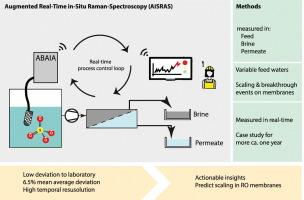用实时增强原位拉曼光谱连续测量硫酸盐以优化矿井水淡化
IF 9.8
1区 工程技术
Q1 ENGINEERING, CHEMICAL
引用次数: 0
摘要
矿物开采在其水资源组合中是非常复杂的,公司经常同时平衡有限的淡水摄入和环境排放。由于水质多变,很难关闭矿井水循环的循环,因此越来越需要海水淡化技术来改善水质,供下游使用或环境上可接受的排放。这些纳滤或反渗透过程的管理需要实时了解水的概况,从微咸水到咸水,以减轻结垢事件,特别是在矿山工艺废水中。上游过程的频繁变化会干扰反渗透操作,而实时、连续的水质监测可以提供即时反馈,以便主动调整化学剂量、维护间隔和操作设定值,以保护膜的使用寿命和维持过程的正常运行时间。我们提出实时增强原位拉曼光谱(AISRAS) -一种利用机器学习与拉曼光谱相结合的技术-连续监测水成分。在一项试点测试中,我们在西非一个接收矿山工艺废水的全规模反渗透设施中测量了硫酸盐,该设施运行了一年多。我们提供了来自四个不同测量点的实时反馈,以直接优化膜处理操作。与实验室取样分析相比,AISRAS的操作偏差小于10%。此外,实验室硫酸盐估计不能提供必要的时间分辨率来精确识别水基质中的突变点。结果表明,通过原位直接测定硫酸盐,可以实现对硫酸钙膜结垢的预防性预测。本文章由计算机程序翻译,如有差异,请以英文原文为准。

Continuous measurement of sulfate to optimize mine water desalination with real-time augmented in-situ raman spectroscopy
Mineral extraction is uniquely complex in its water portfolio, with companies often balancing limiting freshwater intake and environmental discharges simultaneously. Closing the loop on the mine water cycle is difficult with streams of variable quality, and desalination technologies are increasingly required to improve water quality for downstream use or environmentally acceptable discharge. Management of these nanofiltration or reverse osmosis processes requires real-time insight into water profiles, which range from brackish to saline, to mitigate scaling events, particularly on mine process wastewater. Frequent changes in upstream processes disrupt reverse osmosis operation, and real-time, continuous water quality monitoring can provide immediate feedback to allow for proactive adjustment of chemical dosing, maintenance intervals, and operational setpoints to protect membrane life and maintain process uptime.
We propose real-time Augmented in-Situ Raman Spectroscopy (AISRAS) – a technology leveraging machine learning in conjunction with Raman spectroscopy – to continuously monitor water constituents. In a pilot test, we measured sulfate in a full-scale operational reverse osmosis facility receiving mine process wastewater in a Western African location for over one year. We provided real-time feedback from four different measurement points to directly optimize membrane treatment operations. AISRAS operated well below a 10 % deviation margin compared to laboratory grab sample analysis. Furthermore, laboratory sulfate estimations do not provide the necessary temporal resolution to precisely identify sudden change points in the water matrix. We show that by directly measuring sulfate in-situ, preventative prediction of membrane scaling of calcium sulfate could be achieved.
求助全文
通过发布文献求助,成功后即可免费获取论文全文。
去求助
来源期刊

Desalination
工程技术-工程:化工
CiteScore
14.60
自引率
20.20%
发文量
619
审稿时长
41 days
期刊介绍:
Desalination is a scholarly journal that focuses on the field of desalination materials, processes, and associated technologies. It encompasses a wide range of disciplines and aims to publish exceptional papers in this area.
The journal invites submissions that explicitly revolve around water desalting and its applications to various sources such as seawater, groundwater, and wastewater. It particularly encourages research on diverse desalination methods including thermal, membrane, sorption, and hybrid processes.
By providing a platform for innovative studies, Desalination aims to advance the understanding and development of desalination technologies, promoting sustainable solutions for water scarcity challenges.
 求助内容:
求助内容: 应助结果提醒方式:
应助结果提醒方式:


